Ebola Virus: Environmental Aspect - A Review of the Literature
VerifiedAdded on 2022/08/11
|10
|2836
|38
Report
AI Summary
This report is a review of the Ebola virus, focusing on its environmental aspects. It examines the virus's origin, transmission, and persistence, highlighting outbreaks primarily in African countries. The review synthesizes findings from multiple research papers, discussing the virus's viability in fluids, the importance of decontamination, and the role of wastewater in transmission. It emphasizes that Ebola spreads through direct contact with bodily fluids and can persist on surfaces, necessitating strict adherence to decontamination protocols. The review also touches upon the genetic analysis of different Ebola strains and the factors influencing the spread and decline of the virus in West Africa. The conclusion underscores the importance of proper clinical sample preservation and the implementation of stringent guidelines to prevent future outbreaks.
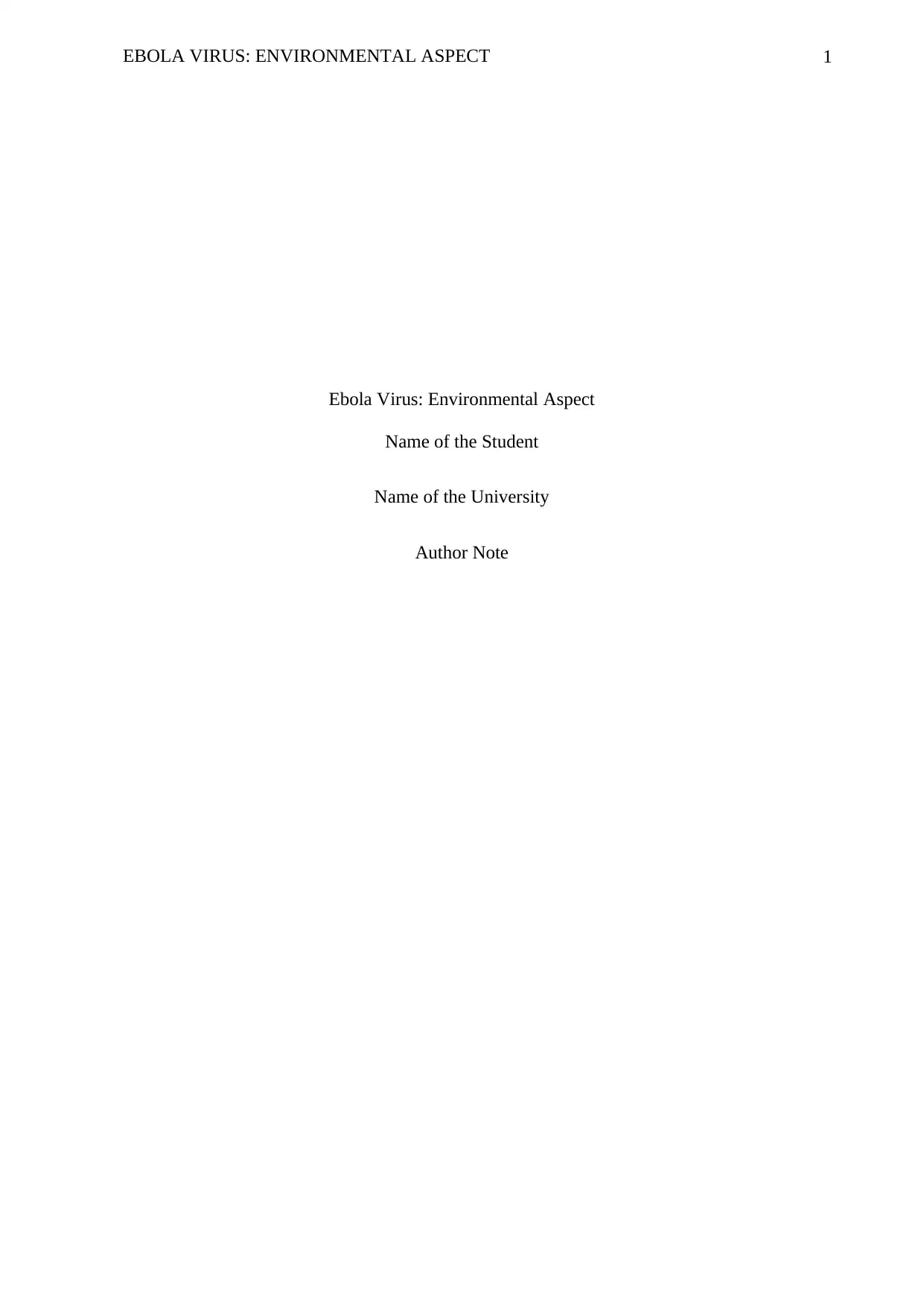
1EBOLA VIRUS: ENVIRONMENTAL ASPECT
Ebola Virus: Environmental Aspect
Name of the Student
Name of the University
Author Note
Ebola Virus: Environmental Aspect
Name of the Student
Name of the University
Author Note
Paraphrase This Document
Need a fresh take? Get an instant paraphrase of this document with our AI Paraphraser
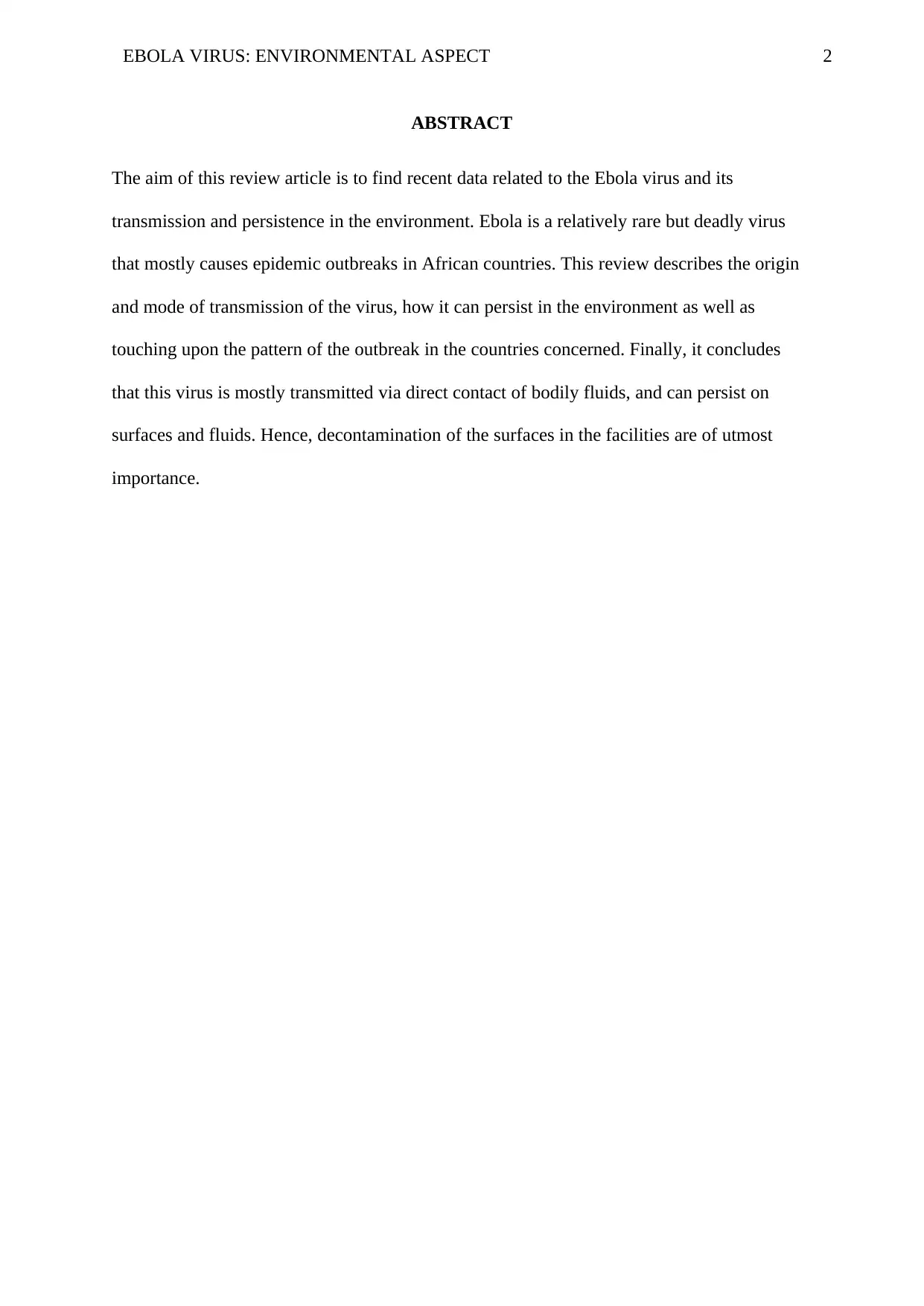
2EBOLA VIRUS: ENVIRONMENTAL ASPECT
ABSTRACT
The aim of this review article is to find recent data related to the Ebola virus and its
transmission and persistence in the environment. Ebola is a relatively rare but deadly virus
that mostly causes epidemic outbreaks in African countries. This review describes the origin
and mode of transmission of the virus, how it can persist in the environment as well as
touching upon the pattern of the outbreak in the countries concerned. Finally, it concludes
that this virus is mostly transmitted via direct contact of bodily fluids, and can persist on
surfaces and fluids. Hence, decontamination of the surfaces in the facilities are of utmost
importance.
ABSTRACT
The aim of this review article is to find recent data related to the Ebola virus and its
transmission and persistence in the environment. Ebola is a relatively rare but deadly virus
that mostly causes epidemic outbreaks in African countries. This review describes the origin
and mode of transmission of the virus, how it can persist in the environment as well as
touching upon the pattern of the outbreak in the countries concerned. Finally, it concludes
that this virus is mostly transmitted via direct contact of bodily fluids, and can persist on
surfaces and fluids. Hence, decontamination of the surfaces in the facilities are of utmost
importance.
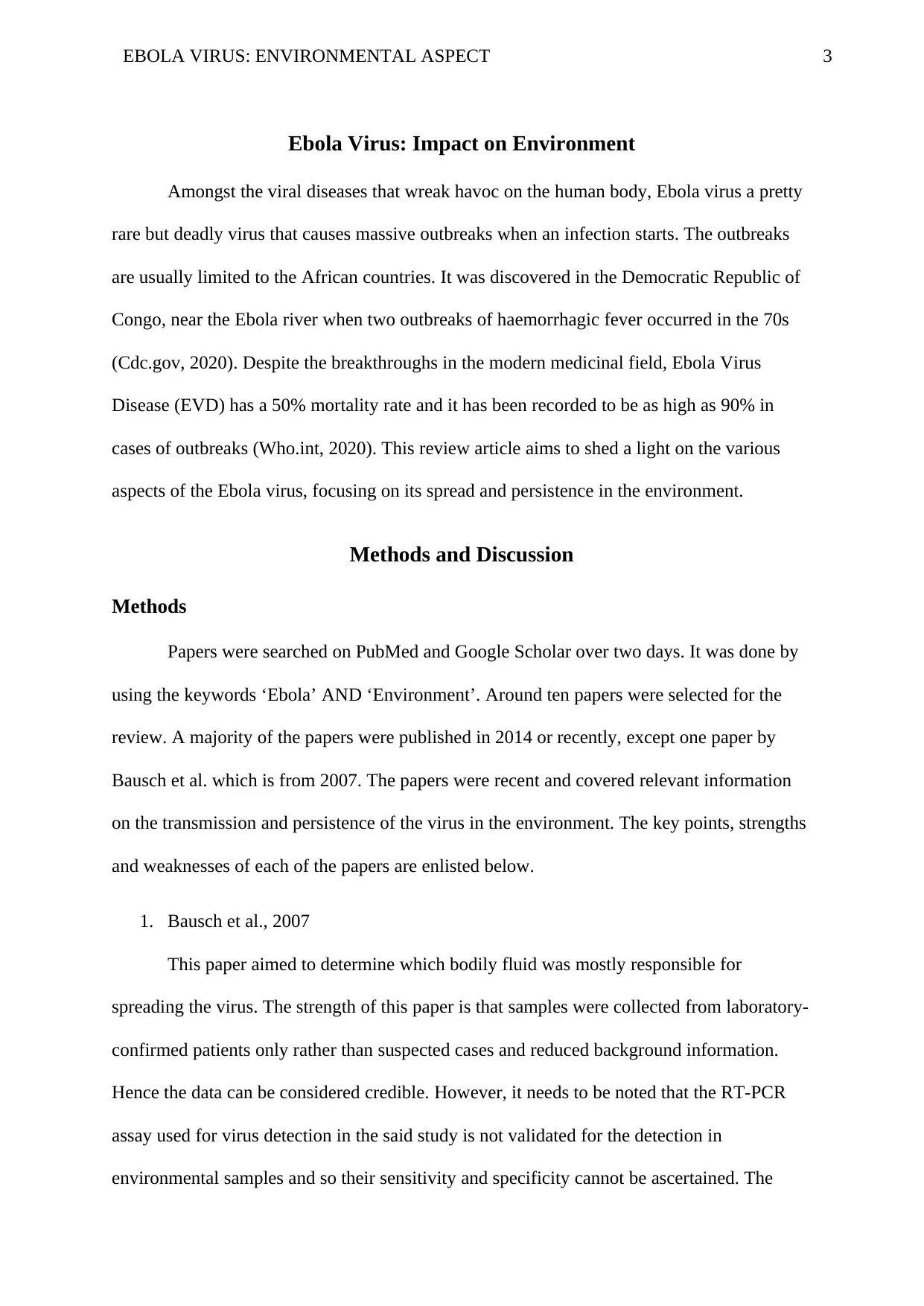
3EBOLA VIRUS: ENVIRONMENTAL ASPECT
Ebola Virus: Impact on Environment
Amongst the viral diseases that wreak havoc on the human body, Ebola virus a pretty
rare but deadly virus that causes massive outbreaks when an infection starts. The outbreaks
are usually limited to the African countries. It was discovered in the Democratic Republic of
Congo, near the Ebola river when two outbreaks of haemorrhagic fever occurred in the 70s
(Cdc.gov, 2020). Despite the breakthroughs in the modern medicinal field, Ebola Virus
Disease (EVD) has a 50% mortality rate and it has been recorded to be as high as 90% in
cases of outbreaks (Who.int, 2020). This review article aims to shed a light on the various
aspects of the Ebola virus, focusing on its spread and persistence in the environment.
Methods and Discussion
Methods
Papers were searched on PubMed and Google Scholar over two days. It was done by
using the keywords ‘Ebola’ AND ‘Environment’. Around ten papers were selected for the
review. A majority of the papers were published in 2014 or recently, except one paper by
Bausch et al. which is from 2007. The papers were recent and covered relevant information
on the transmission and persistence of the virus in the environment. The key points, strengths
and weaknesses of each of the papers are enlisted below.
1. Bausch et al., 2007
This paper aimed to determine which bodily fluid was mostly responsible for
spreading the virus. The strength of this paper is that samples were collected from laboratory-
confirmed patients only rather than suspected cases and reduced background information.
Hence the data can be considered credible. However, it needs to be noted that the RT-PCR
assay used for virus detection in the said study is not validated for the detection in
environmental samples and so their sensitivity and specificity cannot be ascertained. The
Ebola Virus: Impact on Environment
Amongst the viral diseases that wreak havoc on the human body, Ebola virus a pretty
rare but deadly virus that causes massive outbreaks when an infection starts. The outbreaks
are usually limited to the African countries. It was discovered in the Democratic Republic of
Congo, near the Ebola river when two outbreaks of haemorrhagic fever occurred in the 70s
(Cdc.gov, 2020). Despite the breakthroughs in the modern medicinal field, Ebola Virus
Disease (EVD) has a 50% mortality rate and it has been recorded to be as high as 90% in
cases of outbreaks (Who.int, 2020). This review article aims to shed a light on the various
aspects of the Ebola virus, focusing on its spread and persistence in the environment.
Methods and Discussion
Methods
Papers were searched on PubMed and Google Scholar over two days. It was done by
using the keywords ‘Ebola’ AND ‘Environment’. Around ten papers were selected for the
review. A majority of the papers were published in 2014 or recently, except one paper by
Bausch et al. which is from 2007. The papers were recent and covered relevant information
on the transmission and persistence of the virus in the environment. The key points, strengths
and weaknesses of each of the papers are enlisted below.
1. Bausch et al., 2007
This paper aimed to determine which bodily fluid was mostly responsible for
spreading the virus. The strength of this paper is that samples were collected from laboratory-
confirmed patients only rather than suspected cases and reduced background information.
Hence the data can be considered credible. However, it needs to be noted that the RT-PCR
assay used for virus detection in the said study is not validated for the detection in
environmental samples and so their sensitivity and specificity cannot be ascertained. The
⊘ This is a preview!⊘
Do you want full access?
Subscribe today to unlock all pages.

Trusted by 1+ million students worldwide
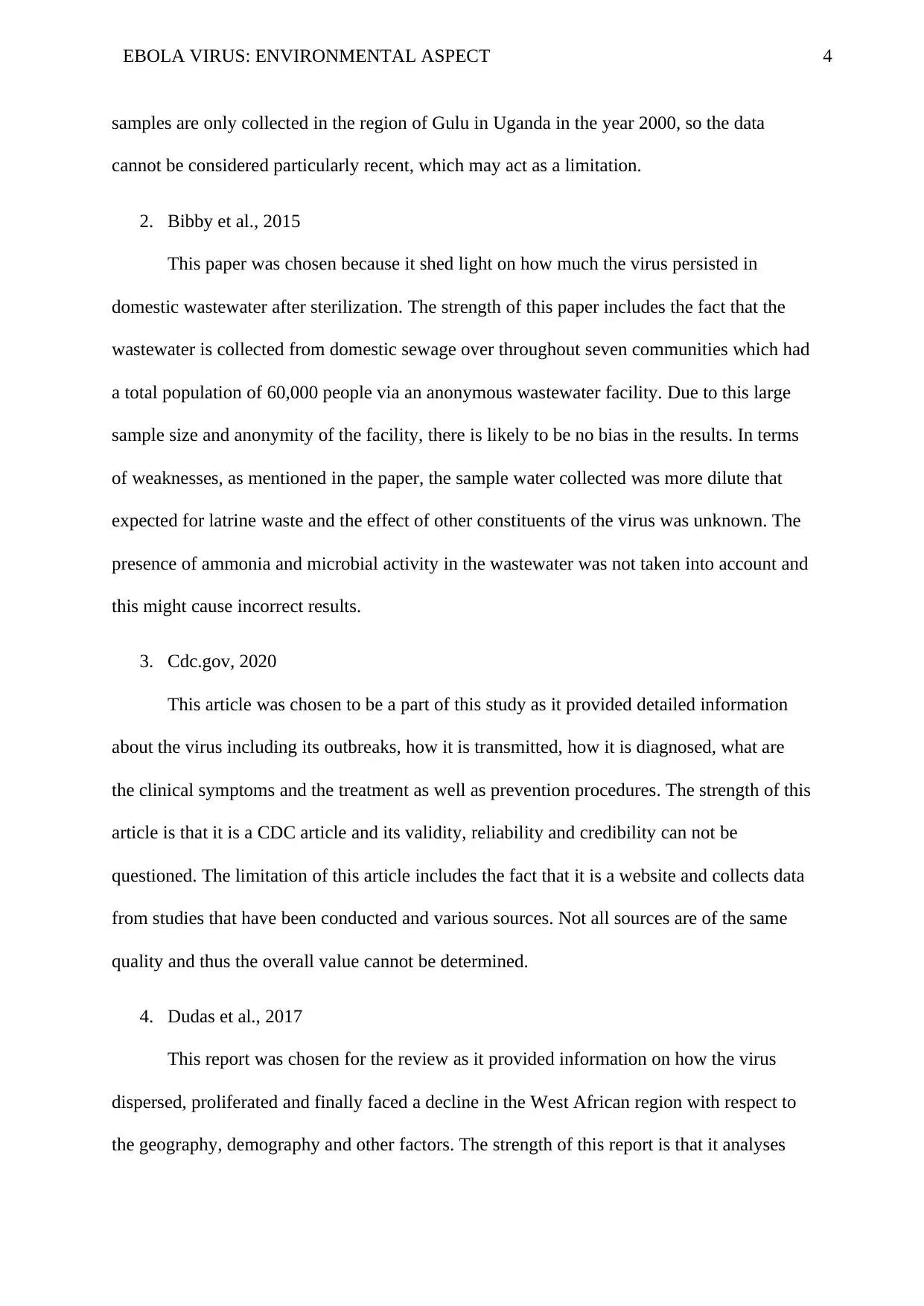
4EBOLA VIRUS: ENVIRONMENTAL ASPECT
samples are only collected in the region of Gulu in Uganda in the year 2000, so the data
cannot be considered particularly recent, which may act as a limitation.
2. Bibby et al., 2015
This paper was chosen because it shed light on how much the virus persisted in
domestic wastewater after sterilization. The strength of this paper includes the fact that the
wastewater is collected from domestic sewage over throughout seven communities which had
a total population of 60,000 people via an anonymous wastewater facility. Due to this large
sample size and anonymity of the facility, there is likely to be no bias in the results. In terms
of weaknesses, as mentioned in the paper, the sample water collected was more dilute that
expected for latrine waste and the effect of other constituents of the virus was unknown. The
presence of ammonia and microbial activity in the wastewater was not taken into account and
this might cause incorrect results.
3. Cdc.gov, 2020
This article was chosen to be a part of this study as it provided detailed information
about the virus including its outbreaks, how it is transmitted, how it is diagnosed, what are
the clinical symptoms and the treatment as well as prevention procedures. The strength of this
article is that it is a CDC article and its validity, reliability and credibility can not be
questioned. The limitation of this article includes the fact that it is a website and collects data
from studies that have been conducted and various sources. Not all sources are of the same
quality and thus the overall value cannot be determined.
4. Dudas et al., 2017
This report was chosen for the review as it provided information on how the virus
dispersed, proliferated and finally faced a decline in the West African region with respect to
the geography, demography and other factors. The strength of this report is that it analyses
samples are only collected in the region of Gulu in Uganda in the year 2000, so the data
cannot be considered particularly recent, which may act as a limitation.
2. Bibby et al., 2015
This paper was chosen because it shed light on how much the virus persisted in
domestic wastewater after sterilization. The strength of this paper includes the fact that the
wastewater is collected from domestic sewage over throughout seven communities which had
a total population of 60,000 people via an anonymous wastewater facility. Due to this large
sample size and anonymity of the facility, there is likely to be no bias in the results. In terms
of weaknesses, as mentioned in the paper, the sample water collected was more dilute that
expected for latrine waste and the effect of other constituents of the virus was unknown. The
presence of ammonia and microbial activity in the wastewater was not taken into account and
this might cause incorrect results.
3. Cdc.gov, 2020
This article was chosen to be a part of this study as it provided detailed information
about the virus including its outbreaks, how it is transmitted, how it is diagnosed, what are
the clinical symptoms and the treatment as well as prevention procedures. The strength of this
article is that it is a CDC article and its validity, reliability and credibility can not be
questioned. The limitation of this article includes the fact that it is a website and collects data
from studies that have been conducted and various sources. Not all sources are of the same
quality and thus the overall value cannot be determined.
4. Dudas et al., 2017
This report was chosen for the review as it provided information on how the virus
dispersed, proliferated and finally faced a decline in the West African region with respect to
the geography, demography and other factors. The strength of this report is that it analyses
Paraphrase This Document
Need a fresh take? Get an instant paraphrase of this document with our AI Paraphraser
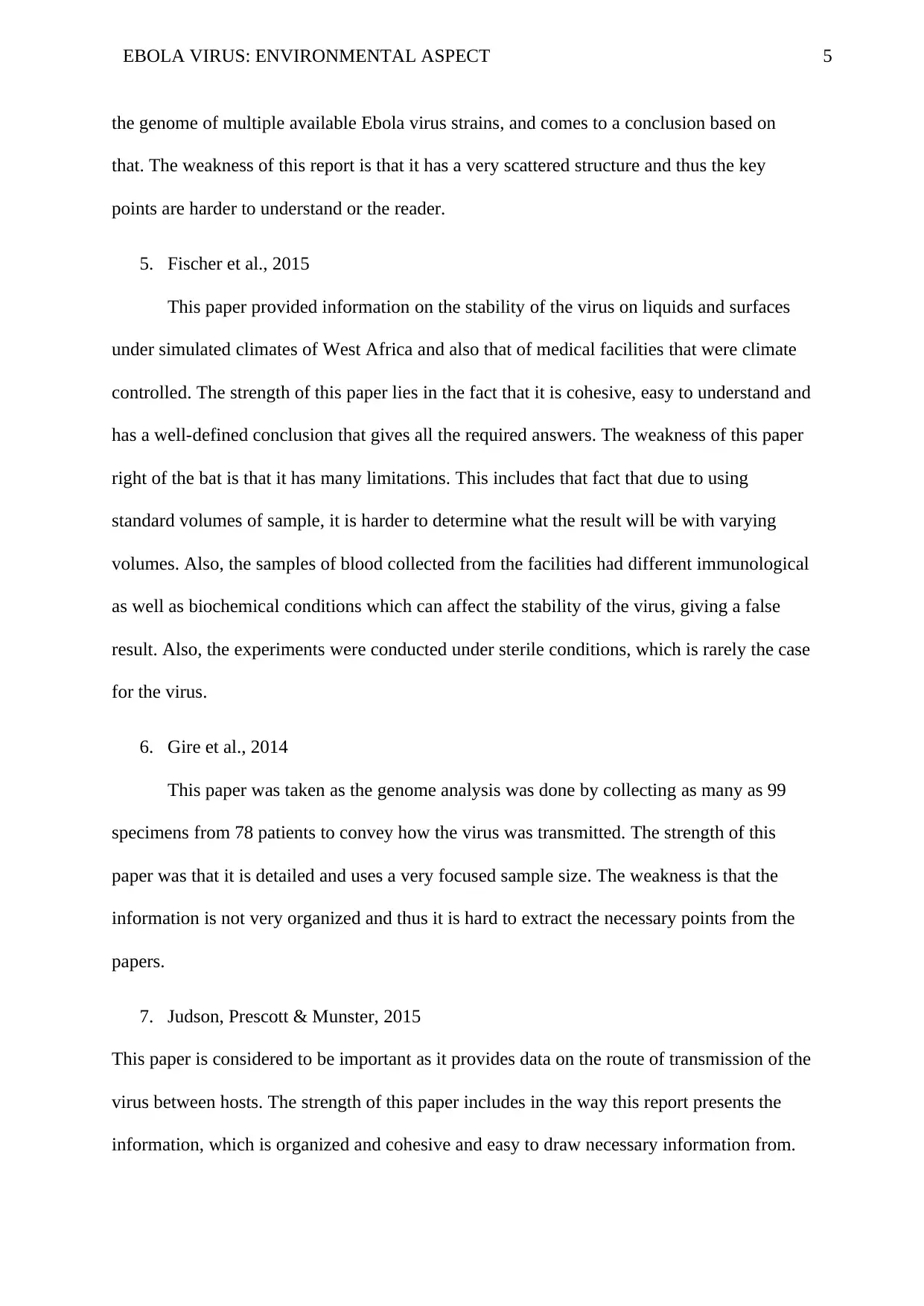
5EBOLA VIRUS: ENVIRONMENTAL ASPECT
the genome of multiple available Ebola virus strains, and comes to a conclusion based on
that. The weakness of this report is that it has a very scattered structure and thus the key
points are harder to understand or the reader.
5. Fischer et al., 2015
This paper provided information on the stability of the virus on liquids and surfaces
under simulated climates of West Africa and also that of medical facilities that were climate
controlled. The strength of this paper lies in the fact that it is cohesive, easy to understand and
has a well-defined conclusion that gives all the required answers. The weakness of this paper
right of the bat is that it has many limitations. This includes that fact that due to using
standard volumes of sample, it is harder to determine what the result will be with varying
volumes. Also, the samples of blood collected from the facilities had different immunological
as well as biochemical conditions which can affect the stability of the virus, giving a false
result. Also, the experiments were conducted under sterile conditions, which is rarely the case
for the virus.
6. Gire et al., 2014
This paper was taken as the genome analysis was done by collecting as many as 99
specimens from 78 patients to convey how the virus was transmitted. The strength of this
paper was that it is detailed and uses a very focused sample size. The weakness is that the
information is not very organized and thus it is hard to extract the necessary points from the
papers.
7. Judson, Prescott & Munster, 2015
This paper is considered to be important as it provides data on the route of transmission of the
virus between hosts. The strength of this paper includes in the way this report presents the
information, which is organized and cohesive and easy to draw necessary information from.
the genome of multiple available Ebola virus strains, and comes to a conclusion based on
that. The weakness of this report is that it has a very scattered structure and thus the key
points are harder to understand or the reader.
5. Fischer et al., 2015
This paper provided information on the stability of the virus on liquids and surfaces
under simulated climates of West Africa and also that of medical facilities that were climate
controlled. The strength of this paper lies in the fact that it is cohesive, easy to understand and
has a well-defined conclusion that gives all the required answers. The weakness of this paper
right of the bat is that it has many limitations. This includes that fact that due to using
standard volumes of sample, it is harder to determine what the result will be with varying
volumes. Also, the samples of blood collected from the facilities had different immunological
as well as biochemical conditions which can affect the stability of the virus, giving a false
result. Also, the experiments were conducted under sterile conditions, which is rarely the case
for the virus.
6. Gire et al., 2014
This paper was taken as the genome analysis was done by collecting as many as 99
specimens from 78 patients to convey how the virus was transmitted. The strength of this
paper was that it is detailed and uses a very focused sample size. The weakness is that the
information is not very organized and thus it is hard to extract the necessary points from the
papers.
7. Judson, Prescott & Munster, 2015
This paper is considered to be important as it provides data on the route of transmission of the
virus between hosts. The strength of this paper includes in the way this report presents the
information, which is organized and cohesive and easy to draw necessary information from.
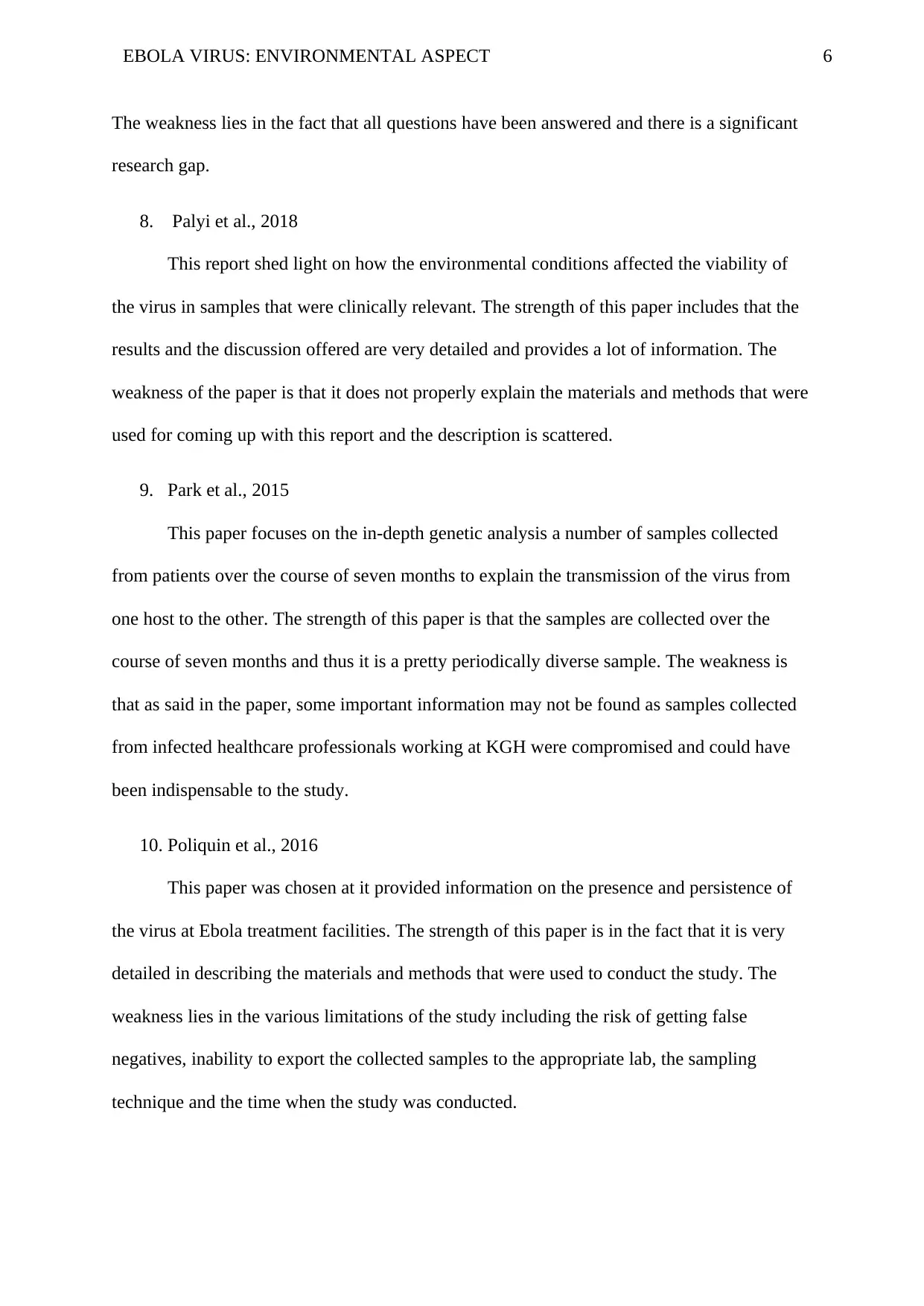
6EBOLA VIRUS: ENVIRONMENTAL ASPECT
The weakness lies in the fact that all questions have been answered and there is a significant
research gap.
8. Palyi et al., 2018
This report shed light on how the environmental conditions affected the viability of
the virus in samples that were clinically relevant. The strength of this paper includes that the
results and the discussion offered are very detailed and provides a lot of information. The
weakness of the paper is that it does not properly explain the materials and methods that were
used for coming up with this report and the description is scattered.
9. Park et al., 2015
This paper focuses on the in-depth genetic analysis a number of samples collected
from patients over the course of seven months to explain the transmission of the virus from
one host to the other. The strength of this paper is that the samples are collected over the
course of seven months and thus it is a pretty periodically diverse sample. The weakness is
that as said in the paper, some important information may not be found as samples collected
from infected healthcare professionals working at KGH were compromised and could have
been indispensable to the study.
10. Poliquin et al., 2016
This paper was chosen at it provided information on the presence and persistence of
the virus at Ebola treatment facilities. The strength of this paper is in the fact that it is very
detailed in describing the materials and methods that were used to conduct the study. The
weakness lies in the various limitations of the study including the risk of getting false
negatives, inability to export the collected samples to the appropriate lab, the sampling
technique and the time when the study was conducted.
The weakness lies in the fact that all questions have been answered and there is a significant
research gap.
8. Palyi et al., 2018
This report shed light on how the environmental conditions affected the viability of
the virus in samples that were clinically relevant. The strength of this paper includes that the
results and the discussion offered are very detailed and provides a lot of information. The
weakness of the paper is that it does not properly explain the materials and methods that were
used for coming up with this report and the description is scattered.
9. Park et al., 2015
This paper focuses on the in-depth genetic analysis a number of samples collected
from patients over the course of seven months to explain the transmission of the virus from
one host to the other. The strength of this paper is that the samples are collected over the
course of seven months and thus it is a pretty periodically diverse sample. The weakness is
that as said in the paper, some important information may not be found as samples collected
from infected healthcare professionals working at KGH were compromised and could have
been indispensable to the study.
10. Poliquin et al., 2016
This paper was chosen at it provided information on the presence and persistence of
the virus at Ebola treatment facilities. The strength of this paper is in the fact that it is very
detailed in describing the materials and methods that were used to conduct the study. The
weakness lies in the various limitations of the study including the risk of getting false
negatives, inability to export the collected samples to the appropriate lab, the sampling
technique and the time when the study was conducted.
⊘ This is a preview!⊘
Do you want full access?
Subscribe today to unlock all pages.

Trusted by 1+ million students worldwide
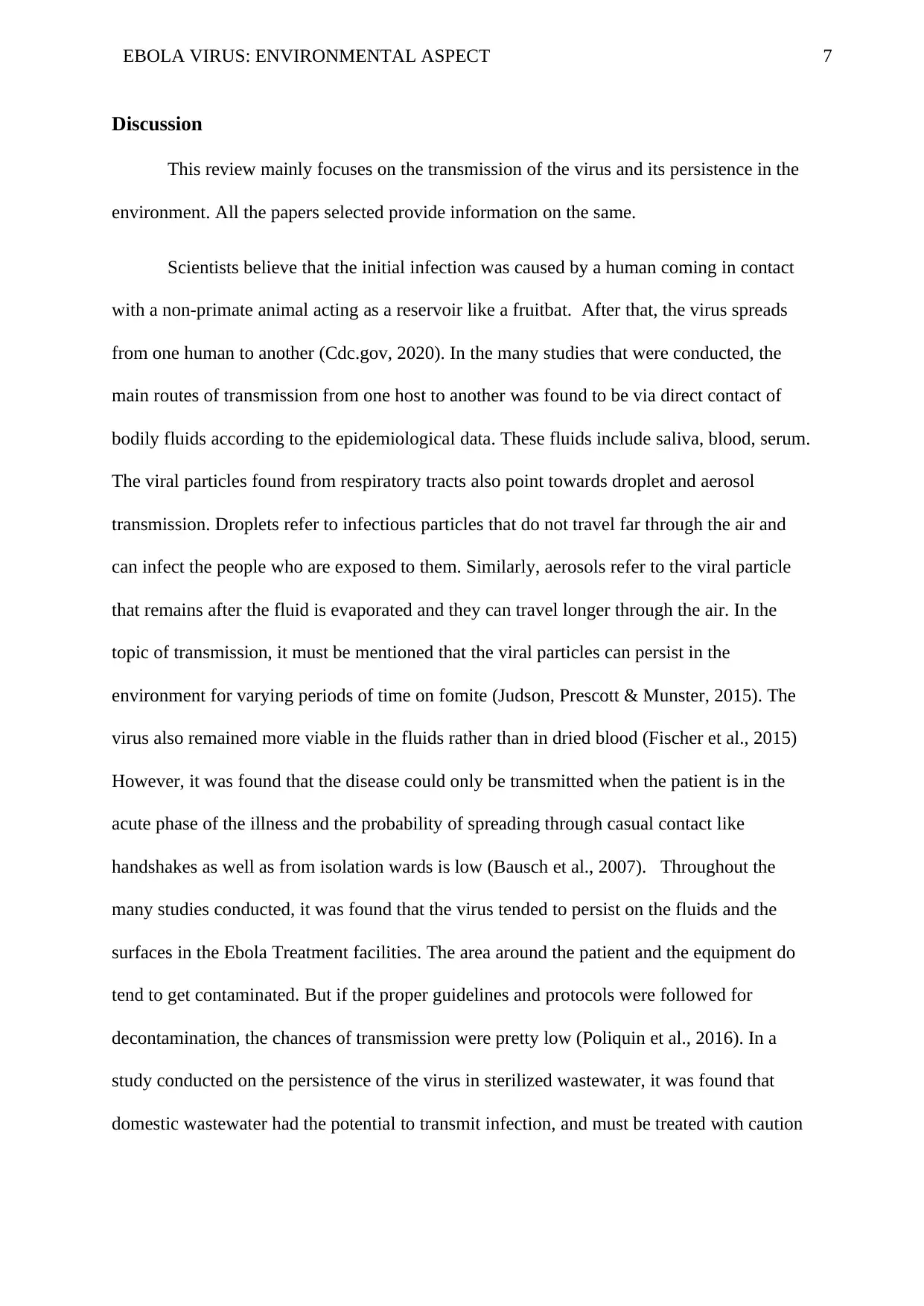
7EBOLA VIRUS: ENVIRONMENTAL ASPECT
Discussion
This review mainly focuses on the transmission of the virus and its persistence in the
environment. All the papers selected provide information on the same.
Scientists believe that the initial infection was caused by a human coming in contact
with a non-primate animal acting as a reservoir like a fruitbat. After that, the virus spreads
from one human to another (Cdc.gov, 2020). In the many studies that were conducted, the
main routes of transmission from one host to another was found to be via direct contact of
bodily fluids according to the epidemiological data. These fluids include saliva, blood, serum.
The viral particles found from respiratory tracts also point towards droplet and aerosol
transmission. Droplets refer to infectious particles that do not travel far through the air and
can infect the people who are exposed to them. Similarly, aerosols refer to the viral particle
that remains after the fluid is evaporated and they can travel longer through the air. In the
topic of transmission, it must be mentioned that the viral particles can persist in the
environment for varying periods of time on fomite (Judson, Prescott & Munster, 2015). The
virus also remained more viable in the fluids rather than in dried blood (Fischer et al., 2015)
However, it was found that the disease could only be transmitted when the patient is in the
acute phase of the illness and the probability of spreading through casual contact like
handshakes as well as from isolation wards is low (Bausch et al., 2007). Throughout the
many studies conducted, it was found that the virus tended to persist on the fluids and the
surfaces in the Ebola Treatment facilities. The area around the patient and the equipment do
tend to get contaminated. But if the proper guidelines and protocols were followed for
decontamination, the chances of transmission were pretty low (Poliquin et al., 2016). In a
study conducted on the persistence of the virus in sterilized wastewater, it was found that
domestic wastewater had the potential to transmit infection, and must be treated with caution
Discussion
This review mainly focuses on the transmission of the virus and its persistence in the
environment. All the papers selected provide information on the same.
Scientists believe that the initial infection was caused by a human coming in contact
with a non-primate animal acting as a reservoir like a fruitbat. After that, the virus spreads
from one human to another (Cdc.gov, 2020). In the many studies that were conducted, the
main routes of transmission from one host to another was found to be via direct contact of
bodily fluids according to the epidemiological data. These fluids include saliva, blood, serum.
The viral particles found from respiratory tracts also point towards droplet and aerosol
transmission. Droplets refer to infectious particles that do not travel far through the air and
can infect the people who are exposed to them. Similarly, aerosols refer to the viral particle
that remains after the fluid is evaporated and they can travel longer through the air. In the
topic of transmission, it must be mentioned that the viral particles can persist in the
environment for varying periods of time on fomite (Judson, Prescott & Munster, 2015). The
virus also remained more viable in the fluids rather than in dried blood (Fischer et al., 2015)
However, it was found that the disease could only be transmitted when the patient is in the
acute phase of the illness and the probability of spreading through casual contact like
handshakes as well as from isolation wards is low (Bausch et al., 2007). Throughout the
many studies conducted, it was found that the virus tended to persist on the fluids and the
surfaces in the Ebola Treatment facilities. The area around the patient and the equipment do
tend to get contaminated. But if the proper guidelines and protocols were followed for
decontamination, the chances of transmission were pretty low (Poliquin et al., 2016). In a
study conducted on the persistence of the virus in sterilized wastewater, it was found that
domestic wastewater had the potential to transmit infection, and must be treated with caution
Paraphrase This Document
Need a fresh take? Get an instant paraphrase of this document with our AI Paraphraser
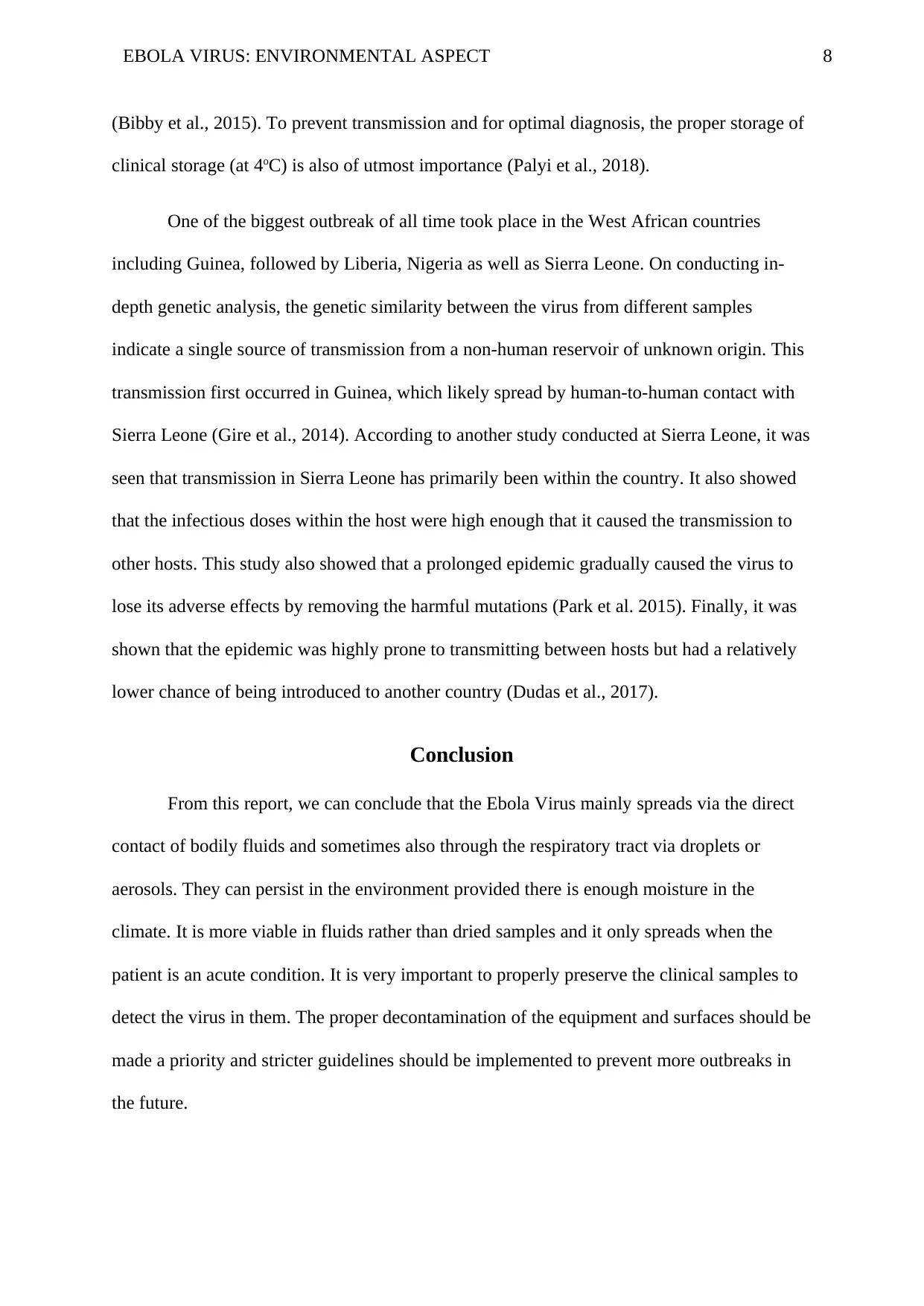
8EBOLA VIRUS: ENVIRONMENTAL ASPECT
(Bibby et al., 2015). To prevent transmission and for optimal diagnosis, the proper storage of
clinical storage (at 4oC) is also of utmost importance (Palyi et al., 2018).
One of the biggest outbreak of all time took place in the West African countries
including Guinea, followed by Liberia, Nigeria as well as Sierra Leone. On conducting in-
depth genetic analysis, the genetic similarity between the virus from different samples
indicate a single source of transmission from a non-human reservoir of unknown origin. This
transmission first occurred in Guinea, which likely spread by human-to-human contact with
Sierra Leone (Gire et al., 2014). According to another study conducted at Sierra Leone, it was
seen that transmission in Sierra Leone has primarily been within the country. It also showed
that the infectious doses within the host were high enough that it caused the transmission to
other hosts. This study also showed that a prolonged epidemic gradually caused the virus to
lose its adverse effects by removing the harmful mutations (Park et al. 2015). Finally, it was
shown that the epidemic was highly prone to transmitting between hosts but had a relatively
lower chance of being introduced to another country (Dudas et al., 2017).
Conclusion
From this report, we can conclude that the Ebola Virus mainly spreads via the direct
contact of bodily fluids and sometimes also through the respiratory tract via droplets or
aerosols. They can persist in the environment provided there is enough moisture in the
climate. It is more viable in fluids rather than dried samples and it only spreads when the
patient is an acute condition. It is very important to properly preserve the clinical samples to
detect the virus in them. The proper decontamination of the equipment and surfaces should be
made a priority and stricter guidelines should be implemented to prevent more outbreaks in
the future.
(Bibby et al., 2015). To prevent transmission and for optimal diagnosis, the proper storage of
clinical storage (at 4oC) is also of utmost importance (Palyi et al., 2018).
One of the biggest outbreak of all time took place in the West African countries
including Guinea, followed by Liberia, Nigeria as well as Sierra Leone. On conducting in-
depth genetic analysis, the genetic similarity between the virus from different samples
indicate a single source of transmission from a non-human reservoir of unknown origin. This
transmission first occurred in Guinea, which likely spread by human-to-human contact with
Sierra Leone (Gire et al., 2014). According to another study conducted at Sierra Leone, it was
seen that transmission in Sierra Leone has primarily been within the country. It also showed
that the infectious doses within the host were high enough that it caused the transmission to
other hosts. This study also showed that a prolonged epidemic gradually caused the virus to
lose its adverse effects by removing the harmful mutations (Park et al. 2015). Finally, it was
shown that the epidemic was highly prone to transmitting between hosts but had a relatively
lower chance of being introduced to another country (Dudas et al., 2017).
Conclusion
From this report, we can conclude that the Ebola Virus mainly spreads via the direct
contact of bodily fluids and sometimes also through the respiratory tract via droplets or
aerosols. They can persist in the environment provided there is enough moisture in the
climate. It is more viable in fluids rather than dried samples and it only spreads when the
patient is an acute condition. It is very important to properly preserve the clinical samples to
detect the virus in them. The proper decontamination of the equipment and surfaces should be
made a priority and stricter guidelines should be implemented to prevent more outbreaks in
the future.
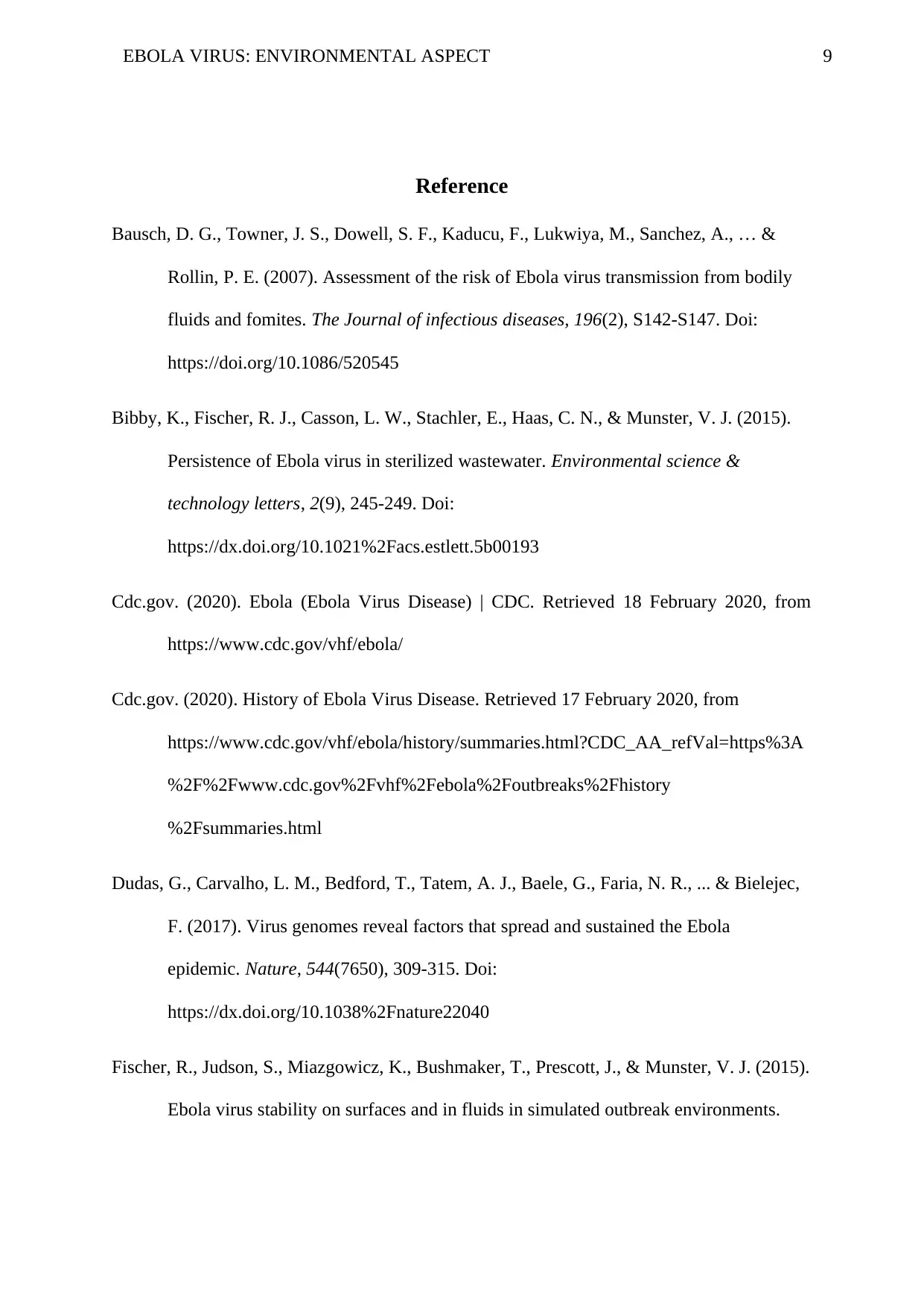
9EBOLA VIRUS: ENVIRONMENTAL ASPECT
Reference
Bausch, D. G., Towner, J. S., Dowell, S. F., Kaducu, F., Lukwiya, M., Sanchez, A., … &
Rollin, P. E. (2007). Assessment of the risk of Ebola virus transmission from bodily
fluids and fomites. The Journal of infectious diseases, 196(2), S142-S147. Doi:
https://doi.org/10.1086/520545
Bibby, K., Fischer, R. J., Casson, L. W., Stachler, E., Haas, C. N., & Munster, V. J. (2015).
Persistence of Ebola virus in sterilized wastewater. Environmental science &
technology letters, 2(9), 245-249. Doi:
https://dx.doi.org/10.1021%2Facs.estlett.5b00193
Cdc.gov. (2020). Ebola (Ebola Virus Disease) | CDC. Retrieved 18 February 2020, from
https://www.cdc.gov/vhf/ebola/
Cdc.gov. (2020). History of Ebola Virus Disease. Retrieved 17 February 2020, from
https://www.cdc.gov/vhf/ebola/history/summaries.html?CDC_AA_refVal=https%3A
%2F%2Fwww.cdc.gov%2Fvhf%2Febola%2Foutbreaks%2Fhistory
%2Fsummaries.html
Dudas, G., Carvalho, L. M., Bedford, T., Tatem, A. J., Baele, G., Faria, N. R., ... & Bielejec,
F. (2017). Virus genomes reveal factors that spread and sustained the Ebola
epidemic. Nature, 544(7650), 309-315. Doi:
https://dx.doi.org/10.1038%2Fnature22040
Fischer, R., Judson, S., Miazgowicz, K., Bushmaker, T., Prescott, J., & Munster, V. J. (2015).
Ebola virus stability on surfaces and in fluids in simulated outbreak environments.
Reference
Bausch, D. G., Towner, J. S., Dowell, S. F., Kaducu, F., Lukwiya, M., Sanchez, A., … &
Rollin, P. E. (2007). Assessment of the risk of Ebola virus transmission from bodily
fluids and fomites. The Journal of infectious diseases, 196(2), S142-S147. Doi:
https://doi.org/10.1086/520545
Bibby, K., Fischer, R. J., Casson, L. W., Stachler, E., Haas, C. N., & Munster, V. J. (2015).
Persistence of Ebola virus in sterilized wastewater. Environmental science &
technology letters, 2(9), 245-249. Doi:
https://dx.doi.org/10.1021%2Facs.estlett.5b00193
Cdc.gov. (2020). Ebola (Ebola Virus Disease) | CDC. Retrieved 18 February 2020, from
https://www.cdc.gov/vhf/ebola/
Cdc.gov. (2020). History of Ebola Virus Disease. Retrieved 17 February 2020, from
https://www.cdc.gov/vhf/ebola/history/summaries.html?CDC_AA_refVal=https%3A
%2F%2Fwww.cdc.gov%2Fvhf%2Febola%2Foutbreaks%2Fhistory
%2Fsummaries.html
Dudas, G., Carvalho, L. M., Bedford, T., Tatem, A. J., Baele, G., Faria, N. R., ... & Bielejec,
F. (2017). Virus genomes reveal factors that spread and sustained the Ebola
epidemic. Nature, 544(7650), 309-315. Doi:
https://dx.doi.org/10.1038%2Fnature22040
Fischer, R., Judson, S., Miazgowicz, K., Bushmaker, T., Prescott, J., & Munster, V. J. (2015).
Ebola virus stability on surfaces and in fluids in simulated outbreak environments.
⊘ This is a preview!⊘
Do you want full access?
Subscribe today to unlock all pages.

Trusted by 1+ million students worldwide
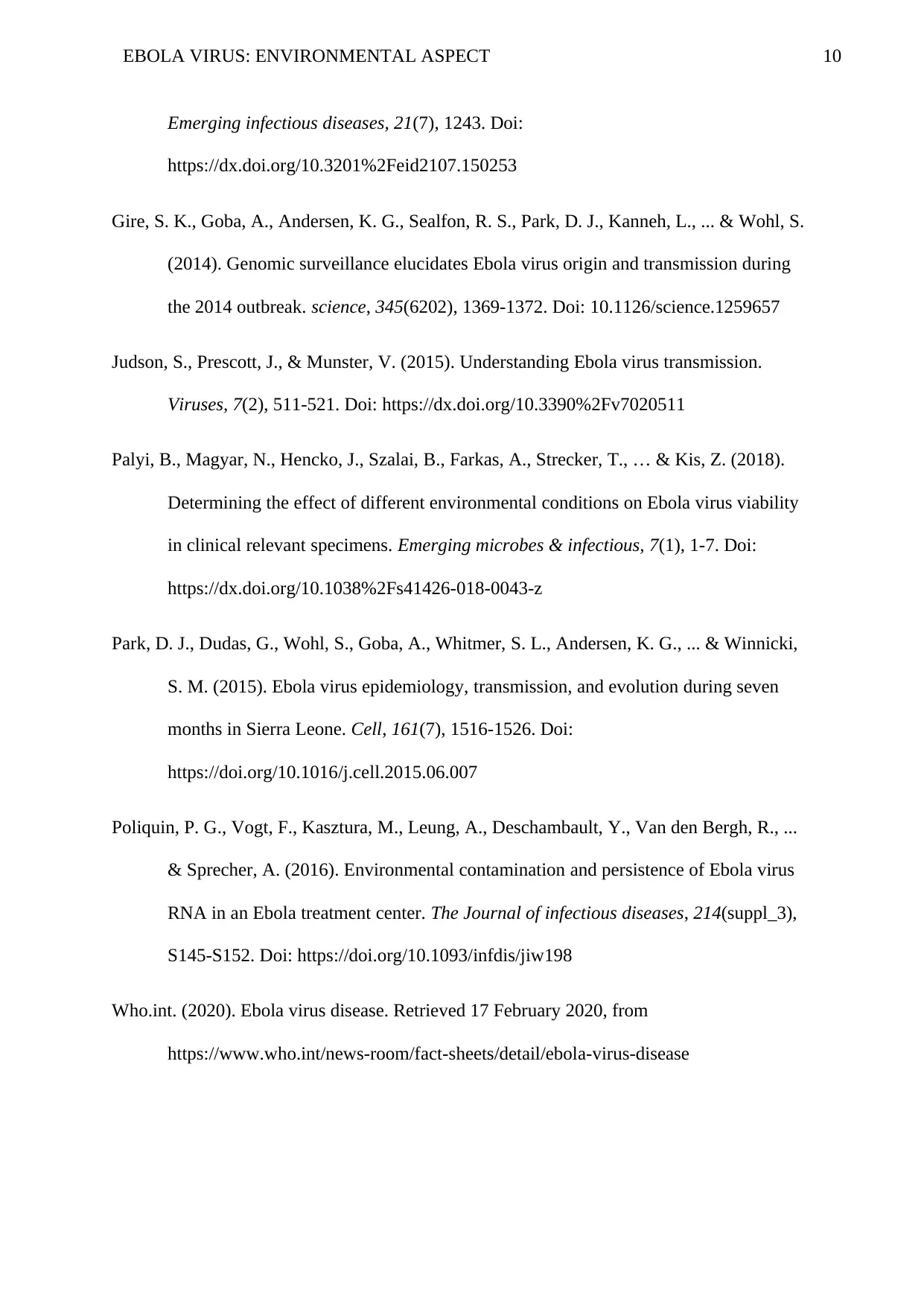
10EBOLA VIRUS: ENVIRONMENTAL ASPECT
Emerging infectious diseases, 21(7), 1243. Doi:
https://dx.doi.org/10.3201%2Feid2107.150253
Gire, S. K., Goba, A., Andersen, K. G., Sealfon, R. S., Park, D. J., Kanneh, L., ... & Wohl, S.
(2014). Genomic surveillance elucidates Ebola virus origin and transmission during
the 2014 outbreak. science, 345(6202), 1369-1372. Doi: 10.1126/science.1259657
Judson, S., Prescott, J., & Munster, V. (2015). Understanding Ebola virus transmission.
Viruses, 7(2), 511-521. Doi: https://dx.doi.org/10.3390%2Fv7020511
Palyi, B., Magyar, N., Hencko, J., Szalai, B., Farkas, A., Strecker, T., … & Kis, Z. (2018).
Determining the effect of different environmental conditions on Ebola virus viability
in clinical relevant specimens. Emerging microbes & infectious, 7(1), 1-7. Doi:
https://dx.doi.org/10.1038%2Fs41426-018-0043-z
Park, D. J., Dudas, G., Wohl, S., Goba, A., Whitmer, S. L., Andersen, K. G., ... & Winnicki,
S. M. (2015). Ebola virus epidemiology, transmission, and evolution during seven
months in Sierra Leone. Cell, 161(7), 1516-1526. Doi:
https://doi.org/10.1016/j.cell.2015.06.007
Poliquin, P. G., Vogt, F., Kasztura, M., Leung, A., Deschambault, Y., Van den Bergh, R., ...
& Sprecher, A. (2016). Environmental contamination and persistence of Ebola virus
RNA in an Ebola treatment center. The Journal of infectious diseases, 214(suppl_3),
S145-S152. Doi: https://doi.org/10.1093/infdis/jiw198
Who.int. (2020). Ebola virus disease. Retrieved 17 February 2020, from
https://www.who.int/news-room/fact-sheets/detail/ebola-virus-disease
Emerging infectious diseases, 21(7), 1243. Doi:
https://dx.doi.org/10.3201%2Feid2107.150253
Gire, S. K., Goba, A., Andersen, K. G., Sealfon, R. S., Park, D. J., Kanneh, L., ... & Wohl, S.
(2014). Genomic surveillance elucidates Ebola virus origin and transmission during
the 2014 outbreak. science, 345(6202), 1369-1372. Doi: 10.1126/science.1259657
Judson, S., Prescott, J., & Munster, V. (2015). Understanding Ebola virus transmission.
Viruses, 7(2), 511-521. Doi: https://dx.doi.org/10.3390%2Fv7020511
Palyi, B., Magyar, N., Hencko, J., Szalai, B., Farkas, A., Strecker, T., … & Kis, Z. (2018).
Determining the effect of different environmental conditions on Ebola virus viability
in clinical relevant specimens. Emerging microbes & infectious, 7(1), 1-7. Doi:
https://dx.doi.org/10.1038%2Fs41426-018-0043-z
Park, D. J., Dudas, G., Wohl, S., Goba, A., Whitmer, S. L., Andersen, K. G., ... & Winnicki,
S. M. (2015). Ebola virus epidemiology, transmission, and evolution during seven
months in Sierra Leone. Cell, 161(7), 1516-1526. Doi:
https://doi.org/10.1016/j.cell.2015.06.007
Poliquin, P. G., Vogt, F., Kasztura, M., Leung, A., Deschambault, Y., Van den Bergh, R., ...
& Sprecher, A. (2016). Environmental contamination and persistence of Ebola virus
RNA in an Ebola treatment center. The Journal of infectious diseases, 214(suppl_3),
S145-S152. Doi: https://doi.org/10.1093/infdis/jiw198
Who.int. (2020). Ebola virus disease. Retrieved 17 February 2020, from
https://www.who.int/news-room/fact-sheets/detail/ebola-virus-disease
1 out of 10
Your All-in-One AI-Powered Toolkit for Academic Success.
+13062052269
info@desklib.com
Available 24*7 on WhatsApp / Email
![[object Object]](/_next/static/media/star-bottom.7253800d.svg)
Unlock your academic potential
Copyright © 2020–2025 A2Z Services. All Rights Reserved. Developed and managed by ZUCOL.
